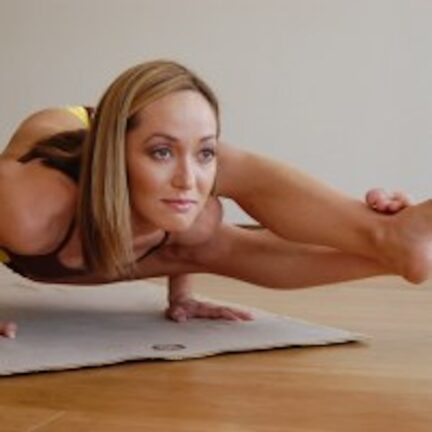Open Your Pelvis: Deep Straddle, Front Splits in Yoga

I grew up in the 1980s in the U.S.A. and one of my first fitness memories was of the “Thigh Master”. This invention was sold as toning the thighs and giving a sleek looking leg to the user. The exercise had the result of tightening the inner thigh muscles. Without much technical instruction the do-it-yourself home workout junkie would just squeeze the inner thighs muscles, including the Adductors, Gracilis and Pectineus. When I started practicing yoga the one area of serious tightness that I found on my body was my inner thighs. When your inner thighs are tight and over worked it can restrict healthy inward and outward rotation of the hip joint. In the yoga practice we rely on a healthy range of motion in the hip joint to practice most of the postures. Yoga practitioners who find their inner thighs a little tight need to take the time to understand how to soften and release this tender area in order to practice safely.
The thighs form the gateway to the pelvis and opening the muscles along the thighs takes patience, humility and good alignment. Between the hamstrings, the quadriceps and the inner thigh muscles, the upper legs create a solid protection for the pelvis. In yoga you practice how to let go of all unnecessary protection so that the body can relax. In essence flexibility is about laying down the armor of the body so its natural state of peace and harmony can be revealed. That’s easier said than done.
When I first started attempting to deepen my front splits I realized that my inner thighs were blocking the pathway. This is a sensitive area to work with in the body that cannot be rushed. In the Ashtanga Yoga Primary Series many students who are eager to open their inner thighs in postures like Upavistha and Supta Konasana end up creating injury out of their enthusiasm. As a teacher I strongly encourage students not to push themselves too hard while in these postures. Eager students will sometimes grab hold of their feet and attempt to force their torso down to the floor between their thighs. But without waiting for the body to relax and release its protection, the tightness around the thighs cannot release and they only end up making their body tighter. In the worst-case scenario that I have witnessed, a student injures their hamstring or inner thigh attachment around the sitting bones while attempting to go deeper. This can all be avoided if you work patiently, surrender the go and apply healthy alignment principles while working the yoga postures.
In the yoga practice, we cannot control when the body will release and open. All we can do is show up each day and practice while letting go of the need to get any particular result. The openings and transformations that happen through yoga practice occur because we surrender ourselves to the divine and in that grace we experience our natural freedom. There is no way to rush that process. But I know first hand how frustrating it can be to turn up every day on your mat and not feel like there is any improvement. When I work with front splits I get impatient and want to hurry along the tedious journey of softening an area of tightness. If you are also working on front splits this video will help you find a safe path to opening the inner thighs.
Yoga Anatomy: Avoid Hand and Wrist Injuries

Think of the number of times your hands and wrists are connected to the earth and carry your weight in a typical Hatha Yoga practice. Like our feet, our hands frequently become a crucial foundation from which our postures build and express themselves. Sustaining mindful engagement of our hands will support a life-long practice that is free of negative stress conditions and injuries to the wrist. Let’s look at some anatomical aspects to give us empowerment and motivation to explore our unique positioning and engagement of the hands and wrists.
The wrists are formed by our 2 forearm bones (the radius and ulna). They meet dat the wrist joint where there is cluster of small bones (carpal bones). The carpal bones connect with 5 long bones (metacarpal bones) that make up the palm of the hand. From there, the metacarpal bones connect to the bones of the fingers (phalanges). The carpal bones form a tunnel through which tendons and nerve tissue pass to service the hand and fingers. One primary focus of hand engagement is to avoid collapsing into this tunnel and keeping excessive pressure from cascading into that track of muscle and nerve tissue.
One primary focus of hand engagement is to avoid collapsing into this tunnel and keeping excessive pressure from cascading into that track of muscle and nerve tissue.
Another key structural area to consider is the joint connection between the ulna and the carpal bones. If you turn your hand open (supination of the forearm and wrist), your ulna is the inside forearm bone (medial side). Unlike the radius (lateral or thumb side) that has a direct joint connection to the carpal bones, the ulna has indirect joint connection. Instead, there is a piece of fibrocartilage (designed to absorb stress forces) between the ulna and carpal bones along with a network of supporting ligaments – this area is called the Triangular Fibrocartilage Complex. When we look at the overall differences in joint connection, the radius also has a larger joint surface compared to the ulna. This gives indication that most people are best served to deliver a greater proportion of their force and energy through the radial side of the wrist than through the ulnar side.





































